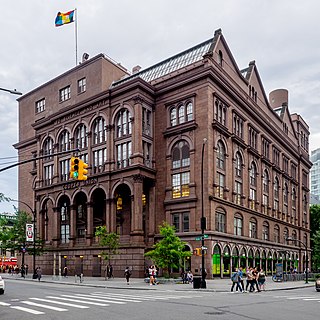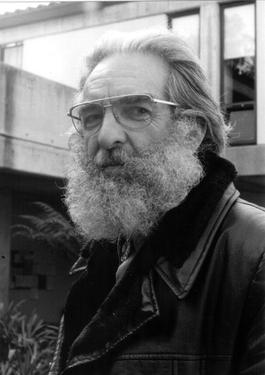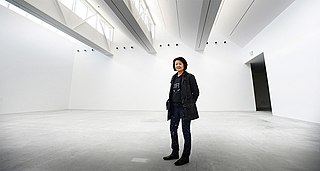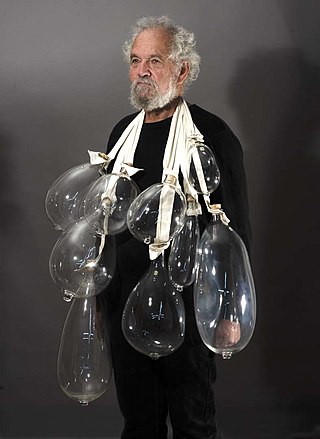
Michael Webb (born 1937) is an English architect. He was a founding member of the 1960s Archigram Group.

Michael Webb (born 1937) is an English architect. He was a founding member of the 1960s Archigram Group.
Webb was born in Henley-on-Thames and studied architecture at the Regent Street Polytechnic in London, taking seventeen years to complete a five-year curriculum. [1]
He was a founding member of the 1960s Archigram Group, a collection of six young radical architects. They used a magazine format, Archigram inflatable structures, clothing-like environments, bright colors and cartoon-like drawing techniques. [2]
Webb moved to the United States in 1965 to teach at Virginia Tech, and has since taught architecture at the Rhode Island School of Design, NJIT, Columbia University, Barnard College, Cooper Union, University at Buffalo, Pratt Institute and Princeton University. [3]
Webb taught a summer semester in Barcelona, Spain to University at Buffalo Master of Architecture students along with Professor Bonnie Ott in the summer of 2001.
He has also put on exhibitions in Europe, Asia, and North America. His latest exhibition, Two Journeys, opened in the fall semester, giving Webb an opportunity for students to learn about him and his work. The exhibit was mounted and read like the pages of a book. It centered on two main themes: a train of thought deriving from the Reyner Banham article A Home is not a House (1965) and a study of linear perspective projection. His monograph Michael Webb: Two Journeys Lars Muller Publishers. [4]
Webb is married to his archivist and technologist, Nancy McCoy. [5] Though retired, he continues to present at Schools of Architecture around the world. Michael and Nancy live in Rhode Island.

Cooper Union for the Advancement of Science and Art, commonly known as Cooper Union, is a private college on Cooper Square in Lower Manhattan, New York City. Peter Cooper founded the institution in 1859 after learning about the government-supported École Polytechnique in France. The school was built on a radical new model of American higher education based on Cooper's belief that an education "equal to the best technology schools established" should be accessible to those who qualify, independent of their race, religion, sex, wealth or social status, and should be "open and free to all".

The Rhode Island School of Design is a private art and design school in Providence, Rhode Island. The school was founded as a coeducational institution in 1877 by Helen Adelia Rowe Metcalf, who sought to increase the accessibility of design education to women. Today, RISD offers bachelor's and master's degree programs across 19 majors and enrolls approximately 2,000 undergraduate and 500 graduate students. The Rhode Island School of Design Museum—which houses the school's art and design collections—is one of the largest college art museums in the United States.

Archigram was an avant-garde British architectural group whose unbuilt projects and media-savvy provocations "spawned the most influential architectural movement of the 1960's," according to Peter Cook, in the Princeton Architectural Press study Archigram (1999). Neofuturistic, anti-heroic, and pro-consumerist, the group drew inspiration from technology in order to create a new reality that was expressed through hypothetical projects, i.e., its buildings were never built, although the group did produce what the architectural historian Charles Jencks called "a series of monumental objects (one hesitates in calling them buildings since most of them moved, grew, flew, walked, burrowed or just sank under the water." The works of Archigram had a neofuturistic slant, influenced by Antonio Sant'Elia's works. Buckminster Fuller and Yona Friedman were also important sources of inspiration.

Sir Peter Cook is an English architect, lecturer and writer on architectural subjects. He was a founder of Archigram, and was knighted in 2007 by the Queen for his services to architecture and teaching. He is also a Royal Academician and a Commandeur de l'Ordre des Arts et des Lettres of the French Republic. His achievements with Archigram were recognised by the Royal Institute of British Architects in 2004, when the group was awarded the Royal Gold Medal.

Blobitecture, blobism and blobismus are terms for a movement in architecture in which buildings have an organic, amoeba-shaped building form. Though the term blob architecture was already in vogue in the mid-1990s, the word blobitecture first appeared in print in 2002, in William Safire's "On Language" column in the New York Times Magazine. Though intended in the Safire article to have a derogatory meaning, the word stuck and is often used to describe buildings with curved and rounded shapes.

Peter Reyner Banham Hon. FRIBA was an English architectural critic and writer best known for his theoretical treatise Theory and Design in the First Machine Age (1960) and for his 1971 book Los Angeles: The Architecture of Four Ecologies. In the latter he categorized the Los Angeles experience into four ecological models and explored the distinct architectural cultures of each. A frequent visitor to the United States from the early 1960s, he relocated there in 1976.

Visionary architecture is a design that only exists on paper or displays idealistic or impractical qualities. The term originated from an exhibit at the Museum of Modern Art in 1960. Visionary architects are also known as paper architects because their improbable works exist only as drawings, collages, or models. Their designs show unique, creative concepts that are unrealistic or impossible except in the design environment.
Megastructure is an architectural and urban concept of the post-war era, which envisions a city or an urban form that could be encased in a massive single human-made structure or a relatively small number of interconnected structures. In a megastructural project, orders and hierarchies are created with large and permanent structures supporting small and transitional ones.

Raimund Johann Abraham was an Austrian architect.
Bowellism is a modern architectural style heavily associated with Richard Rogers. It is described as a transient architectural and flippant style that was influenced by Le Corbusier and Antoni Gaudí. The style consists of services for the building, such as ducts, sewage pipes, and lifts, being located on the exterior to maximise space in the interior.
Ronald James Herron was an English architect and teacher. He is perhaps best known for his work with the seminal experimental architecture collective Archigram, which was formed in London in the early 1960s. Herron was the creator of one of the group's best known and celebrated projects, the Walking City.

Theo Crosby was an architect, editor, writer and sculptor, engaged with major developments in design across four decades. He was also an early vocal critic of modern urbanism. He is best remembered as a founding partner of the international design partnership Pentagram, and as architect for the reconstruction of Shakespeare's Globe in London. However, his role as éminence grise in British architecture and design from 1950 to 1990 helped effect much broader changes. Crosby's archive is located at the University of Brighton Design Archives.

Philippe Rahm Dipl. EPFL - Ecole Polytechnique Fédérale de Lausanne - Switzerland 1993 is a principal architect in the office of Philippe Rahm architectes, based in Paris, France. His work, which extends the field of architecture from the physiological scale of the body to the climatic scale of the city has received an international audience in the context of sustainability.

Nader Tehrani is an Iranian-American designer and educator.

Toshiko Mori is a Japanese architect and the founder and principal of New York–based Toshiko Mori Architect, PLLC and Vision Arc. She is also the Robert P. Hubbard Professor in the Practice of Architecture at the Harvard University Graduate School of Design. In 1995, she became the first female faculty member to receive tenure at the GSD.
Hilary Sample is an American architect, principal, and co-founder of the award-winning architecture firm MOS Architects in New York City.
Nancy Goldring is an American artist. Her art practice combines graphic, photographic, and projected material, presented as a non-narrative series of images that she calls "foto-projections." Goldring currently lives and works in New York City, and is a professor emerita, Montclair State University.

Irwin Rubin was an American artist and educator known for his colorfully painted wood constructions.

Allan Wexler is an American interdisciplinary artist and educator. A practicing artist since the early 1970s, Wexler works with sculpture, photography and photo-based drawings that poetically and often humorously explore the natural world, our senses and how our environment affects daily rituals.
British high-tech architecture is a form of high-tech architecture, also known as structural expressionism, a type of late modern architectural style that emerged in the 1970s, incorporating elements of high tech industry and technology into building design. High-tech architecture grew from the modernist style, using new advances in technology and building materials.